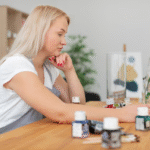In the UK where there’s no guarantee of sunny days, it is crucial to focus on seeking protection from skin cancer by covering yourself from the sun during scorching heat waves. Besides these intense heat waves, it is equally essential to safeguard your skin health throughout the entire of the summer season. Melanoma skin cancer, the 5th most frequent cancer in the UK, must be treated seriously. Luckily, it is found that approximately 86% of cases can be avoided. So let’s find out how you can protect your skin from damage, get your moles checked and when to see your GP.
What Is Melanoma?
Melanoma is a form of skin cancer that happens when skin pigment cells (melanocytes) begin to grow and divide more quickly than normal. Melanoma is nearly always treatable if detected and treated on time.
But if left untreated, melanoma can enter into the deeper layers of your skin that have blood vessels and lymphatic vessels. This makes it easy to spread to other regions of the body, becoming hard to treat and may even be fatal at times. The number of melanoma cases diagnosed in the UK has risen lately to more than 15,000 every year. It is among the most prevalent cancers among 15 to 34-years old individuals, but 50% of those diagnosed are mostly above 65.
Tips to Prevent Melanoma
1. Stay out of the sun
Whenever possible you must target to avoid the sun, particularly during the hottest time of the day – between 11 am and 3 pm. This is when the UV rays of the sun are in their strongest and harshest form, capable of making the worst damage. If you are going out during this period, always try and get yourself into a nice shady area to stay out of the sun.
2. Cover up
Just like avoiding the sun, if that is not an option, then you can choose to wear light and comfortable clothes which keep your arms and legs covered. And also consider putting on a hat to shield your face, head, ears and neck.
3. Be familiar with your skin
It is worth noting every small to big change on your skin, so that you can be aware of the right time to visit a GP. Try to get familiar with your skin, be aware where your moles are, and keep track of any new pigmentation changes or anything else that could change. If you are familiar with your ‘normal’ skin, it will be far easier to spot anything unusual.
4. Don’t use sunbeds
Sunbeds, sun lamps and tanning beds give off the same kind of unhealthy radiation as the sun. Tanning with these regularly means it adds to your chances of getting skin cancer. Sunbeds often emit more UV rays than even the strong midday sun!
5. Use a high-factor sun cream
If you can see that you are going to be out in the sun then it is necessary to look after your skin with sun cream. Ensure that you get a sun cream with a factor not lower than SPF 15 and ensure that you keep reapplying it during the day. Do your best to avoid getting sun burns; if you find that your skin is getting red then go inside, find some shade or cover yourself up with clothing.
Recognising the Signs of Melanoma
The very first signs appearing in melanoma include skin changes or a new mole. On the other hand, melanoma can develop from a pre-existing freckle or mole. It is essential to undertake a skin assessment every month – from head to toe – to find out any early signs of potential skin cancer. Observe if you have new growths or moles, or any changes to skin lesions or exiting moles as well. Use this following ABCDE guide cited below to check your moles, and also book a GP appointment at once you notice more than one abnormal feature of your skin.
- Asymmetry: Check if a half of your mole matches the other half, means if they are symmetrical.
- Borders: Look at if clear borders are visible around your mole.
- Colour: Look for colour changes of your mole.
- Diameter: Check for the diameter or size of your mole – it must not be bigger than a pencil rubber.
- Evolution: Keep track if your mole evolves over time.
Who are at higher risk of developing melanoma?
Though melanoma may affect anyone, some people have a greater risk because of environmental, lifestyle or genetic reasons. If you have fair skin that burns quickly, red or blonde hair, a genetic history of skin cancer, or many freckles or moles, your risk level multiplies by several times. Those with a history of repeated sunburns – particularly in childhood or who work outside – are at higher risk as well. Also people with weakened immune systems or those who have used sunbeds extensively are highly prone to these risks. If you fit into any of these groups, it’s high time that you keep a close eye on your skin and visit your GP or dermatologist regularly for check-ups.
Conclusion
Early identification is the key when it comes to melanoma. By staying protected from sun, checking your skin regularly, and understanding when to take advice from a doctor, you can lower your risk dramatically. Don’t dismiss changes in your skin or your mole – your watchfulness may just save your life.
If you have spotted a suspicious-looking mole (large or small, old or new), it is always advisable to have it checked out by a doctor or skin specialist. At South Kensington MD, our GPs can examine any moles you are concerned about and refer you on to a specialist if needed. Booking an appointment with us is easy and quick, so if you have any concerns whatsoever, we are here to help you out.
Make your private GP consultation in South Kensington today at our clinic. Remember peace of mind is just a consultation away!
- Melanoma Signs: When to Check Moles for Skin Cancer
- Learn when to get moles checked for melanoma. Understand early warning signs, risk factors & importance of early diagnosis to protect your skin health.
- Melanoma, Private doctor
Related posts:
 How Laparoscopic Simulators Improve Precision & Reduce Surgical Errors
How Laparoscopic Simulators Improve Precision & Reduce Surgical Errors
 Exploring the Best Non – Surgical Treatments for Fibroids in Gurgaon
Exploring the Best Non – Surgical Treatments for Fibroids in Gurgaon
 Comprendiendo el Precio de Trasplante de Cabello y Sus Factores
Comprendiendo el Precio de Trasplante de Cabello y Sus Factores
 When Should I Be Concerned About Cramping During My Pregnancy?
When Should I Be Concerned About Cramping During My Pregnancy?
 Understanding the Growth of the Premenstrual Syndrome (PMS) and Menstrual Health Supplements Market
Understanding the Growth of the Premenstrual Syndrome (PMS) and Menstrual Health Supplements Market
 Premium Roofing Tile Solutions in Des Moines, IA by Joury Tile Service
Premium Roofing Tile Solutions in Des Moines, IA by Joury Tile Service
 How a Verified Gastroenterologist Email List Transformed a Healthcare Marketing Campaign
How a Verified Gastroenterologist Email List Transformed a Healthcare Marketing Campaign
 Best veneers houston: Can the Best Veneers Fix Crooked or Chipped Teeth?
Best veneers houston: Can the Best Veneers Fix Crooked or Chipped Teeth?






